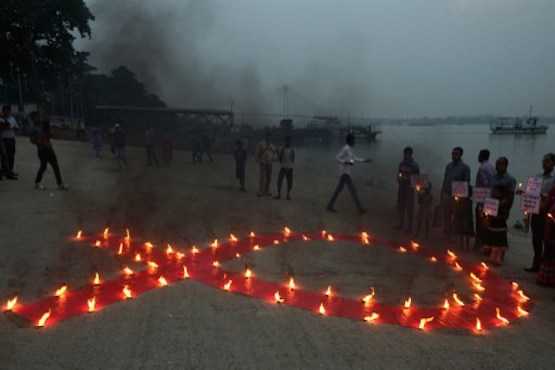
Indian social activists and children light a World AIDS Day awareness sign in Kolkata on Dec. 1, 2015. (Photo by AFP)
While more people in Asia have access to HIV treatment than ever before, vulnerable populations of transgender people, gay men, sex workers, and intravenous drug users continue to see rising rates of infection, according to the United Nations.
In a UNAIDS report released Nov. 22, the agency highlighted massive progress made globally in lowering AIDS-related deaths by expanding HIV treatment.
"The Asia and Pacific region is making significant strides in ensuring people living with HIV lead healthy and productive lives" Steve Kraus, Director of UNAIDS Regional Support Team for Asia and the Pacific, said in a statement.
"In the past five years more than one million people have started accessing antiretroviral treatment. This is a huge achievement."
But country-by-country, and population-by-population, the treatment figures vary greatly. Of the estimated 5.1 million people living with HIV, only 2.1 million have access to the antiretrovirals that save and extend lifespans.
Forty-one percent of adults have access to the medication, 41 percent of children, and 39 percent of pregnant women, which puts Asia well below the global averages of 46, 49, and 77 percent respectively.
In India, the government has been working to enact a policy aiming for zero HIV births and the government has expanded treatment to 100,000 more people in the past year. Only Nigeria had more new infections among children last year, according to the UNAIDS report.
Myanmar, which has seen steep drops in new infections, has struggled to provide care under an ailing health sector, said local groups.
Julia Aye Thida, coordinator of the Myanmar Catholic HIV/AIDS Network at the Catholic Bishops' Conference of Myanmar, said that advocacy to government departments and the parliament has improved under Aung San Suu Kyi's government.
"But stigma and discrimination has remained in Myanmar and more awareness programs are really needed," Aye Thida told ucanews.com.
She called for prioritizing funding for HIV/AIDS, and spending more on treatment, services, and raising awareness among ordinary people — especially pregnant women.
Some 210,000 people are living with HIV/AIDS in Myanmar and some 160,000 receive antiretroviral treatment according to Medecins Sans Frontieres.
"The numbers of people with HIV could become higher so HIV/AIDS is a big issue in Myanmar. But it is not a priority for international donors so we are now facing dwindling funds to carry on our ministry," said Aye Thida.
Government spending on health care was the lowest in Southeast Asia. According to a 2013 World Health Organization report, Myanmar came last in a 190 countries list for overall health system performance.
At the other end of the spectrum stands Sri Lanka, with one of the lowest HIV prevalence rates in the region. According to Health Minister Rajitha Senaratne, the rate is less than 0.01 percent of the population.
The number of people living with HIV is estimated to be around 4,200 in a population of 20 million. But while the rate is extremely low, officials have raised concern over stigmatization and insufficient education.
In February, a primary school in Western Sri Lanka made headlines after parents stopped sending their children to school amid fears one student had AIDS.
While much of the region has been making progress, Pakistan has struggled to keep up. A research study coordinated by the Institute for Health Metrics and Evaluation at the University of Washington in Seattle found the number of new HIV infections in Pakistan grew at an average of 17.6 percent per year between 2005 and 2015, making it the highest increase in the world.
"Our biggest problem is lack of awareness. Living in a religious society, HIV is still considered a taboo and not accepted as a disease like others. It is only near World AIDS Day that media talks about this issue; both parliamentarians and community leaders do not discuss it otherwise," Nazir Masih CEO and founder of the New Lights AIDS Control Society told ucanews.com.
Masih became the first person in Pakistan to openly declare himself as living with HIV after he returned from Dubai in the early 1990s. After facing years of discrimination, he started the first organization in Pakistan to work with people living with HIV/AIDS and their families in 1999.
Masih said patients struggle to access lifesaving medications. "The government uses UN funds to buy expensive anti-retroviral drugs but the patients do not get it regularly. Most of the time there is a gap of 5 to 6 months between the doses," he said. Most ARV therapy requires twice-daily treatment.
John Zaw in Mandalay, Kamran Chaudhry in Lahore, Quintus Colombage in Colombo contributed to this report.


